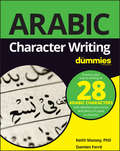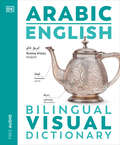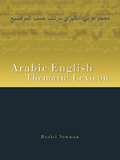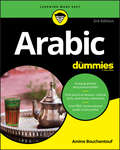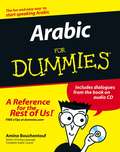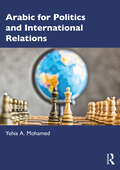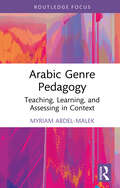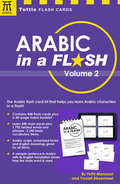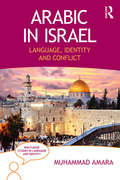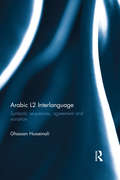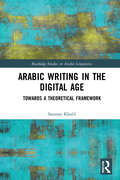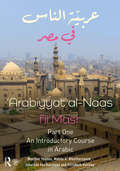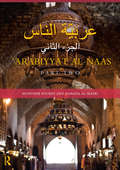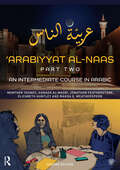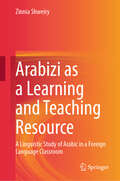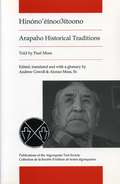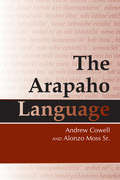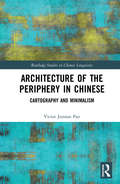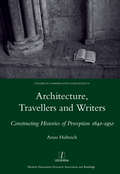- Table View
- List View
Arabic
by Karin C. RydingThis new edition, updated and with additional exercises, equips those who work, travel, and study in Arab countries with an educated form of spoken Arabic that functions flexibly in the face of various regional colloquial variants in the Arab world. Because the Arabic language has a number of very different spoken vernaculars, being able to speak and be understood in all Arab countries has become a challenge for English speakers. Ryding and Mehall have designed a course that teaches a standardized variant of spoken Arabic that is close to, but more natural than, the literary Modern Standard Arabic. With a non-grammar-based approach, this book fosters communicative competence in Arabic on all levels and develops speaking proficiency without abandoning Arabic script. It has proven to be clear, effective, and relevant to the needs of Americans living and working in the Arab East. Task-based lessons feature basic dialogues between Americans and Arabs, explanations of new structures, vocabulary expansion, and exercises; and provide gradual access to the sounds and script of Arabic by emphasizing listening and reading comprehension first, then slowly adding oral exercises and activities until the student has achieved basic proficiency. Not intended for self-instruction for beginners, Formal Spoken Arabic Basic Course with MP3 Files assumes some previous knowledge of Modern Standard Arabic, Arabic script and phonology, and previous or simultaneous instruction in orthography. This new edition includes a CD of MP3 audio exercises that are keyed to the text and drill students on listening and speaking. Lessons cover topics including:Heads of StateCities and CountriesOfficial TitlesGeographySystems of GovernmentLost LuggageGetting AcquaintedEstablishing Common GroundSeeking and Giving InformationPersonal Needs and FamilyHandling ProblemsEating OutBargaining and Buying
Arabic Character Writing For Dummies
by Keith Massey Damien FerréLearn to write in Arabic In Arabic, there are different levels of language. The written language, which is studied in this book, is literary Arabic, sometimes also called classical Arabic or even modern or standard Arabic. It is the language of the Quran, classical poetry, literature and the media. The Arabic plume consists of 28 consonants and three long vowels. Each consonant is accompanied by a vowel which is placed above or below the consonant. Arabic speakers are in great demand in the United States, due to the country's political commitments to the Middle East, but only 25 percent of non-native speakers know the language in enough detail to function as translators, interpreters, analysts, or field agents. Arabic Character Writing For Dummies helps you write this language clearly and correctly. Learn to write the Arabic alphabet Find free instructional videos, flashcards, and printable writing pages online Build upon your mastery of the language Get ahead at work or in your personal life Arabic Character Writing For Dummies is designed for beginners, students, and lifelong learners wishing to write in Arabic.
Arabic - English Bilingual Visual Dictionary (DK Bilingual Visual Dictionaries)
by DKWith more than 6,750 fully illustrated words and phrases in Arabic and English, along with a free bilingual audio app, DK's Arabic-English Bilingual Visual Dictionary is your essential companion to learning Arabic.You will find all the words and phrases you need to buy food and clothes, talk about work and education, visit the doctor, go to the bank, use public transportation, and much more. Perfect for students, tourists, and business travelers, the dictionary is incredibly easy to follow, with thematically organized vocabulary so you can find closely related words on a particular topic. Words and phrases are illustrated with full-color photographs and artwork, helping to fix new vocabulary in your mind. The supporting audio app enables you to hear all the words and phrases spoken out loud in both languages to help you learn, remember, and pronounce important vocabulary.
Arabic-English Thematic Lexicon
by Daniel L. NewmanThe Arabic-English Thematic Lexicon is an invaluable resource for all learners of Arabic. It contains some 8,000 entries, arranged into themes, including flora and fauna, food and drink, the human body, health care, the family, housing, clothing, education, IT, sports, politics, economics and commerce, the law, media, language, geography, travel, religion, arts, science, and natural resources. Three appendices cover the names of Arab and selected non-Arab regions, countries and capitals, and international organizations. The entries in the Lexicon have been drawn from an extensive corpus of contemporary Standard Arabic vocabulary, based on authentic sources. In addition to verbs, nouns and adjectives, the Lexicon includes phrases and commonly used collocations, providing users with the necessary vocabulary in order to communicate effectively and confidently in both written and spoken standard Arabic. The Lexicon provides an indispensable complement to Arabic grammar instruction and also serves as a useful reference guide for all Arabic language users.
Arabic For Dummies
by Amine BouchentoufStart reading and speaking Arabic Arabic For Dummies helps readers start speaking Modern Standard Arabic in no time. Whether you’re a student, traveler, or work in business or government, you’ll find this title to be packed with practical lessons, cultural facts, and handy references. Inside, you’ll find guidance on basic grammar, as well as the necessary vocabulary to make introductions and greetings, use proper etiquette, make small talk, make transportation arrangements, order food and beverages, ask directions, deal with money, shop, access recreation, and handle an emergency. Features new and revised content Offers a revamped, user-friendly design to both pedagogy and organization Includes expanded coverage of grammar, verb conjugations, and pronunciations Get free access to conversational audio tracks online If you want to start speaking Arabic, this go-to book is packed with practical instruction, cultural facts, and handy references you won’t want to be without!
Arabic For Dummies
by Amine BouchentoufRegarded as one of the most difficult languages to learn for native English speakers by the U. S. State Department, Arabic is gaining both prominence and importance in America. Recent world events have brought more and more Americans and other English speakers into contact with Arabic-speaking populations, and governments and businesses are increasingly aware of the importance of basic Arabic language skills. Arabic for Dummies provides you with a painless and fun way to start communicating in Arabic. Why should you learn Arabic? Well, besides the fact that over 200 million people in more than 22 nations use it to communicate, there are tons of reasons to get up to speed this 1,400 year old language, including: Nearly all of the Middle-East speaks Arabic or one of its dialects Basic Arabic skills are extremely useful for anyone traveling to, doing business in, or serving in the Middle East It is the language in which the Koran is written There is a rich, centuries-old literary tradition in Arabic Arabic For Dummies presents the language in the classic, laid-back For Dummies style. Taking a relaxed approach to this difficult language, it's packed with practice dialogues and communication tips that will have you talking the talk in no time. You'll get the scoop on: The Arabic alphabet, pronunciation, basic grammar, and the rules of transliteration The history of the language and information on classical Arabic and its dialects How to make small talk and make yourself understood when dining, shopping, or traveling around town How to communicate on the phone and in business conversations Handy words and phrases for dealing with money, directions, hotels, transportation, and emergencies Arabic culture and etiquette, including ten things you should never do in Arabic countries The book also includes an Arabic-English dictionary, verb tables, and an audio CD with dialogues from the book to help you perfect your pronunciation. Written by a native Arabic speaker who helped start a year-round Arabic department at Middlebury College, Arabic For Dummies is just what you need to start making yourself understood in Arabic. Note: CD-ROM/DVD and other supplementary materials are not included as part of eBook file.
Arabic for Politics and International Relations
by Yehia A. MohamedArabic for Politics and International Relations is the first textbook for high-intermediate to advanced students of Arabic that focuses on Arabic as it is used in the fields of politics, diplomacy, governance, and international relations.Thematically organised, each chapter includes a selection of authentic reading texts that demonstrate the language in use while introducing students to a key topic or theme such as political systems, government, human rights, conflict resolution, and defence. Each chapter has a range of exercises that include comprehension questions, questions designed to develop vocabulary, understanding the morphology, rhetoric and style. There are a range of activities that allow students to practice all four language skills: reading, listening, speaking, and writing.Arabic for Politics and International Relations is ideal for advanced- level Arabic courses.
Arabic Genre Pedagogy: Teaching, Learning, and Assessing in Context (Topics in Arabic Applied Linguistics)
by Myriam Abdel-MalekArabic Genre Pedagogy: Teaching, Learning, and Assessing in Context views Modern Standard Arabic and all spoken varieties of Arabic as one system and offers genre-based instructional resources grounded in systemic functional linguistics (SFL) and genre theory. Divided into three parts, this book explores the Theoretical and Instructional Framework, Spoken Genres, and Written Genres with chapters focusing on everyday social genres including exchanging information, chit-chat, and complaints. This book is aligned with the ACTFL framework and the instructional goals for each genre are articulated in terms of the ACTFL Can-Do Statements. Designed to support instructors of Arabic novice-intermediate learners, the chapters offer step-by-step lessons with practical classroom activities on how to make the language related to each genre explicit to students. Arabic Genre Pedagogy serves as a valuable guide and professional development resource for instructors of Arabic as a world language and for researchers of SFL-informed genre-based approach.
Arabic Grammar in Context (Languages in Context)
by Mohammad AlhawaryArabic Grammar in Context offers a unique and exciting approach to learning grammar. It presents grammar as a necessary and essential tool for understanding Arabic and for developing comprehension and production skills. Features include: authentic texts from a rich variety of sources, literary and non-literary, used as the starting point for the illustration and explanation of key areas of Arabic grammar clear and authoritative demonstration of the relevance of grammar for understanding and interpreting Arabic a wide range of appropriate exercises designed to consolidate learning fully vocalized exercises and texts a glossary of vocabulary and expressions provided at the end of the book audio readings of the texts available online for additional listening practice. Suitable for class use and independent study, Arabic Grammar in Context is ideal for intermediate to advanced learners of Arabic.
Arabic in a Flash Kit Volume 1
by Fethi MansouriArabic in a Flash: Volume I is an excellent new language learning resource for beginning students of Arabic.This unique set of flash cards enables learners to acquire basic Arabic words and their derivatives in an easy-to-use manner at whatever pace the learner prefers. Each card has Arabic script on one side, with romanized forms and English meanings/derivatives agiven on the other. Contains 448 flash cards plus a 32-page index booklet.Learn 448 main words plus 1,792 related words and phrases--2,700 basic vocabulary items.Arabic script, romanized forms and English meanings given for all items.A sample sentence in Arabic with English translation shows how the main word is used.
Arabic in a Flash Volume 2
by Fethi Mansouri Yousef AlreemawiArabic in a Flash: Volume 2 is an excellent language learning resource for beginning-intermediate students of Arabic.Hot on the success of Volume 1, Arabic in a Flash Volume 2 continues to develop the language skills of the beginning students and others interested in learning Arabic. While Volume 1 has a strong focus on basic communication and vocabulary-building, Volume 2 works to further develop vocabulary and introduces everyday activities, travel and leisure and economic and employment issues.Contains 448 flash cards plus a 48-page index booklet.Learn 448 main words plus 1,792 related words and phrases-2,240 basic vocabulary items.Arabic script, romanized forms and English meanings given for all items.A sample sentence in Arabic with its English translation shows how the main word is used.
Arabic in Israel: Language, Identity and Conflict (Routledge Studies in Language and Identity)
by Muhammad AmaraIn Arabic in Israel, Muhammad Amara analyses the status of Arabic following the creation of the State of Israel and documents its impact on the individual and collective identity of Israel’s Palestinian Arab citizens. The interplay of language and identity in conflict situations is also examined. This work represents the culmination of many years of research on Arabic linguistic repertoire and educational policy regarding the language of the Palestinian citizens of Israel. It draws all of these factors together while linking them to local, regional and global developments. Its perspective is interdisciplinary and, as such, examines the topic from a number of angles including linguistic, social, cultural and political.
Arabic in the City: Issues in Dialect Contact and Language Variation (Routledge Arabic Linguistics Series #Vol. 5)
by Catherine Miller Enam Al-Wer Dominique Caubet Janet C. E. WatsonFilling a gap in the literature currently available on the topic, this edited collection is the first examination of the interplay between urbanization, language variation and language change in fifteen major Arab cities. The Arab world presents very different types and degrees of urbanization, from well established old capital-cities such as Cairo to new emerging capital-cities such as Amman or Nouakchott, these in turn embedded in different types of national construction. It is these urban settings which raise questions concerning the dynamics of homogenization/differentiation and the processes of standardization due to the coexistence of competing linguistic models. Topics investigated include: History of settlement The linguistic impact of migration The emergence of new urban vernaculars Dialect convergence and divergence Code-switching, youth language and new urban culture Arabic in the Diaspora Arabic among non-Arab groups. Containing a broad selection of case studies from across the Arab world and featuring contributions from leading urban sociolinguistics and dialectologists, this book presents a fresh approach to our understanding of the interaction between language, society and space. As such, the book will appeal to the linguist as well as to the social scientist in general.
Arabic L2 Interlanguage: Syntactic sequences, agreement and variation (Topics in Arabic Applied Linguistics)
by Ghassan HusseinaliArabic L2 Interlanguage is a significant and timely addition to the field of Second Language Acquisition, providing valuable insight into the development of ‘interlanguage’, the interim language of early beginners, in learners of Arabic. This book: Clearly establishes what interlanguage is and why it should form an important part of foreign language teaching Presents the reader with a sequence in which six English-speaking learners of Arabic acquire the language Makes use of the rich morphological and syntactic property of Arabic to offer a new perspective on the field of Second Language Acquisition. Arabic L2 Interlanguage contributes directly towards building a more comprehensive theoretical framework for explaining how L2s are acquired. It will be key text for SLA scholars as well as an important resource for graduate students in Linguistics and Foreign Language Teaching.
Arabic Stories for Language Learners
by Hezi Brosh Lutfi MansurArabic Stories for Language Learners--a language learning experience for beginner to intermediate students.The traditional stories of a country are invaluable at providing insight into understanding the culture, history and language of a people. The sixty-six stories found in Arabic Stories for Language Learners present the vocabulary and grammar used everyday in Arabic-speaking countries. Pulled from a wide variety of sources that have been edited and simplified for learning purposes, these stories are presented in parallel Arabic and English, facilitating language learning in the classroom and via self-study. Each story is followed by a series of questions in Arabic and English to test comprehension and encourage discussion.Arabic Stories for Language Learners brings Arab culture to life in a colorful and immediate way. Regardless of whether or not you have a working knowledge of Arabic, this book gives readers a tantalizing introduction to the wisdom and humor of these ancient desert-dwelling peoples. An audio CD in Arabic and English helps students of Arabic improve their pronunciation and inflection, and immerses non-students into the uniquely Arabic storytelling style.
Arabic Writing in the Digital Age: Towards a Theoretical Framework (Routledge Studies in Arabic Linguistics)
by Saussan KhalilThe written and spoken forms of Arabic have been traditionally viewed as separate forms of the language that rarely overlap in writing, but this book will examine the recently emerged concept of ‘mixed’ writing that combines both written and spoken forms. This book takes a close look at different examples of mixed Arabic writing in modern (twentieth to twenty-firstt century) print and online literature, offering an analysis of this type of mixing alongside a dynamic model for analysing mixed Arabic writing, and the motivations for producing this type of writing. This book further introduces the ground-breaking concept of the seven writing styles for Arabic, ranging from Classical Arabic to ChatSpeak, whilst also offering an overview of early Arabic literacy and children’s literature. Primarily aimed at Arabic researchers and teachers in linguistics, sociolinguistics, identity studies, politics and Teaching Arabic as a Foreign Language, this book would also be informative for undergraduate and postgraduate students studying Arabic as foreign language, Arabic linguistics and dialectology.
Arabiyyat al-Naas fii MaSr (Part One): An Introductory Course in Arabic
by Munther Younes Makda Weatherspoon Elizabeth Huntley Jonathan Featherstone‘Arabiyyat al-Naas fii MaSr (Part One) offers a ground-breaking introduction to Arabic as it is written and spoken by native speakers. It combines a progressive and rigorous grounding in Modern Standard Arabic (MSA), the register employed for reading, writing and formal speaking, with an innovative integration of the dominant Egyptian variety. Introducing the two simultaneously and seamlessly building on their shared features, ‘Arabiyyat al-Naas fii MaSr (Part One) uses each in its proper context: Egyptian dialect for conversations and MSA for reading and writing activities. In this way, the course efficiently prepares students for the practical realities of learning and living Arabic today. Features include: Expanded grammar explanations and activation drills, including discussions about colloquial and formal similarities and differences A series of authentic video-clips recorded in Egypt to help learners revise the vocabulary and structures then learn unit by unit Extensive classroom activities and homework exercises that provide constant review to reinforce learning Arabic-English and English-Arabic glossaries, reference charts, and a grammar index Songs with simple lyrics tied to the themes of the course to help advance vocabulary acquisition and understanding of basic grammatical structures A companion website (www.routledge.com/cw/weatherspoon) that features fully integrated interactive, self-correcting exercises, audio and video materials, and additional online course management and grading options for teachers A user-friendly and vibrant text design with full colour, richly illustrated throughout with over two hundred illustrations and photos A teachers manual with an Arabic introduction for the teacher, which lays out the structure of the student course book, its methodology and directions and suggestions for its use. Written by experienced teachers of Arabic and experts in Arabic teaching pedagogy, ‘Arabiyyat al-Naas fii MaSr (Part One) is an essential resource for students beginning to learn Arabic.
Arabiyyat al-Naas (Part Two): An Intermediate Course in Arabic
by Munther Younes Hanada Al-MasriArabiyyat al Naas (Part Two): An Intermediate Course in Arabic offers a vibrant course in Arabic as it is written and spoken today by educated native speakers. Not only does it continue the innovative integration of Modern Standard Arabic (MSA) and Levantine Arabic used in Part One of the series, but it does so in a way that supports and develops students’ increased mastery of the language. Combining a greater focus on cultural topics with an increased coverage of MSA, Part Two introduces more sophisticated communication, giving students a deeper awareness of the cultural base of the Arabic language. Features include: Twenty-one theme-based units covering a wide range of relevant and engaging topics, including education and learning, jobs and professions, the Arab woman, religion, money and the economy, politics and government and the environment Thorough coverage of listening, speaking, writing and reading skills in every unit, with lessons structured to provide students with variety, stimulation and further opportunities for practice Humorous, realistic dialogues reflecting everyday educated speech among Arabs to build up strong and practical communication skills A rich variety of reading passages, including poems, short stories, newspaper articles, descriptions of Arab cities and biographies of famous figures, designed to improve comprehension and analytical skills and to deepen students’ knowledge of Arab history, culture, language, and literature An extensive range of appealing exercises and activities, including crossword puzzles, root-and-pattern identification exercises, passage completions, guided and free compositions, and songs Free accompanying CD that includes audio recordings of the listening materials in the 21 units and a number of songs tied to their themes Free companion website (www.routledge.com/cw/younes) featuring the texts of the listening passages, the audio recordings available on the CD , a track list of all the audio materials, the answer keys to the crossword puzzles, sample tests and language games. Developed by an experienced and dynamic author team and tested over a number of years at Cornell University, Arabiyyat al Naas (Part Two) will be an essential resource for intermediate-level students of Arabic. While primarily designed for classroom use, the accessibility of the course also renders it highly suitable for independent study. This volume is the second in a pioneering three-part series of Arabic textbooks which together provide a complete three-year undergraduate language program.
'Arabiyyat al-Naas (Part Two): An Intermediate Course in Arabic
by Munther Younes Hanada Al-Masri Jonathan Featherstone Elizabeth Huntley Makda Weatherspoon‘Arabiyyat al-Naas (Part Two) is an Arabic language textbook designed to bring learners from a lower to a higher intermediate level of language proficiency. Using the Common European Framework Reference, it takes the learner from B.1 to B.2 and, in terms of the levels of the American Council on the Teaching of Foreign Languages, it takes the learner from Intermediate Low to Intermediate High/Advanced Low. The book is a continuation of the first level books in this series (either Arabiyyat al-Naas fii Bilaad al-Shaam or Arabiyaat al-Naas fii maSr ) and follows the Integrated Approach to Arabic instruction. It is a theme-based textbook delivered in the form of a serialized radio drama. Through the lens of journalism and personal interactions modelled by the main characters of this radio drama, learners are equipped to continue developing their spoken and written Arabic skills in the context of authentic dialogues and reading texts. As such, this book reflects cross-dialectal communication as used by native speakers across the Arab world.
'Arabiyyat al-Naas (Part Two): An Intermediate Course in Arabic
by Munther Younes Hanada Al-Masri Jonathan Featherstone Elizabeth Huntley Makda WeatherspoonArabiyyat al Naas (Part Two): An Intermediate Course in Arabic, second edition, offers a vibrant course in Arabic as it is written and spoken today by educated native speakers. It is a theme-based textbook delivered in the form of a serialized radio drama. Through the lens of journalism and personal interactions modelled by the main characters of this radio drama, learners are equipped to continue developing their spoken and written Arabic skills in the context of authentic dialogues and reading texts. As such, this book reflects cross-dialectal communication as used by native speakers across the Arab world.Features include: Twenty-one theme-based units covering a wide range of relevant and engaging topics Thorough coverage of listening, speaking, writing and reading skills in every unit, with lessons structured to provide students with variety, stimulation and further opportunities for practice Humorous, realistic dialogues reflecting everyday educated speech among Arabs to build up strong and practical communication skills Free companion website (www.routledge.com/cw/younes) featuring extensive audio recordings of the listening materials in the textbook, videos that supplement the textbook, and texts of the listening passages in the textbook Developed by an experienced and dynamic author team and tested over a number of years at Cornell University, Arabiyyat al Naas (Part Two) will be an essential resource for intermediate-level students of Arabic. While primarily designed for classroom use, the accessibility of the course also renders it highly suitable for independent study. Using the Common European Framework Reference, it takes the learner from B.1 to B.2 and, in terms of the levels of the American Council on the Teaching of Foreign Languages, it takes the learner from Intermediate Low to Intermediate High/Advanced Low.This volume is the second in a pioneering three-part series of Arabic textbooks which together provide a complete three-year undergraduate language program.
Arabizi as a Learning and Teaching Resource: A Linguistic Study of Arabic in a Foreign Language Classroom
by Zinnia ShweiryThis book is the first of its genre to explore the use of Arabizi, the Romanized script of the Arabic language that is used online or in chat apps, in the Arabic as a Foreign Language (AFL) classroom. It fills a noticeable, and glaring, gap in teaching a non-Romanized language through Romanized representation by observing and studying Arabizi as a resource that is yet to be acknowledged. As such, the author aptly, and concurrently, addresses concerns and problems that arise in AFL learning. An essential resource for studies in language acquisition, the author carves a new niche in the study of phonology, and phonetics, particularly so in L1 and L2 studies, with succinct and up-to-date examples. Relevant to applied linguistics and language educators in Arabic, it also draws comparisons between Chinese and Arabic alphabets in analyzing L1 and L2 purposes, making it a unique linguistic comparative contribution to the study of languages in classroom settings.
Arapaho Historical Traditions: Hinono'einoo3itoono (Algonquian Text Society)
by Alonzo Moss, Sr.Told by Paul Moss (1911-1995), a highly respected storyteller and ceremonial leader, these twelve texts introduce us to an immensely rich literature. As works of an oral tradition, they had until now remained beyond the reach of those who do not speak the Arapaho language. Here, for the first time, these outstanding examples of indigenous North American literature are printed in their original language (in the standard orthography used on the Wind River Reservation) but made accessible to a wider audience through English translation and comprehensive introductions, notes, commentaries and an Arapaho-English glossary.The Arapaho traditions chosen for this anthology tell of hunting, scouting, fighting, horse-stealing, capture and escape, friendly encounters between tribes, diplomacy and war, conflict with the U.S. and battles with its troops. They also include accounts of vision quests and religious rites, the fate of an Arapaho woman captured by Utes, and Arapaho uses of the "Medicine Wheel"in the Bighorn Mountains.
The Arapaho Language: Language And Power Among The Northern Arapaho
by Andrew Cowell Alonzo Moss, Sr.The Arapaho Language is the definitive reference grammar of an endangered Algonquian language. Arapaho differs strikingly from other Algonquian languages, making it particularly relevant to the study of historical linguistics and the evolution of grammar. Andrew Cowell and Alonzo Moss Sr. document Arapaho's interesting features, including a pitch-based accent system with no exact Algonquian parallels, radical innovations in the verb system, and complex contrasts between affirmative and non-affirmative statements. Cowell and Moss detail strategies used by speakers of this highly polysynthetic language to form complex words and illustrate how word formation interacts with information structure. They discuss word order and discourse-level features, treat the special features of formal discourse style and traditional narratives, and list gender-specific particles, which are widely used in conversation. Appendices include full sets of inflections for a variety of verbs. Arapaho is spoken primarily in Wyoming, with a few speakers in Oklahoma. The corpus used in The Arapaho Language spans more than a century of documentation, including multiple speakers from Wyoming and Oklahoma, with emphasis on recent recordings from Wyoming. The book cites approximately 2,000 language examples drawn largely from natural discourse - either recorded spoken language or texts written by native speakers. With The Arapaho Language, Cowell and Moss have produced a comprehensive document of a language that, in its departures from its nearest linguistic neighbors, sheds light on the evolution of grammar.
Architecture of the Periphery in Chinese: Cartography and Minimalism (Routledge Studies in Chinese Linguistics)
by Victor Junnan PanArchitecture of the Periphery in Chinese offers a comprehensive survey on the fine structure of the sentence peripheral domain in Mandarin Chinese from a cartographic perspective. Different functional projections hosting sentence-final particles, implicit operators and other informational components are hierarchically ordered according to the "Subjectivity Scale Constraint" functioning at syntax-discourse interface. Three questions will be essentially addressed: What is the order? How to determine such an order? Why such an order? This research not only gives a thorough examination of the peripheral elements in Chinese but also improves the general understanding of the ordering issue in the left-periphery crosslinguistically. This book is aimed at scholars interested in Chinese syntax or generative syntax.
Architecture, Travellers and Writers: Constructing Histories of Perception 1640-1950
by Anne HultzschDoes the way in which buildings are looked at, and made sense of, change over the course of time? How can we find out about this? By looking at a selection of travel writings spanning four centuries, Anne Hultzsch suggests that it is language, the description of architecture, which offers answers to such questions. The words authors use to transcribe what they see for the reader to re-imagine offer glimpses at modes of perception specific to one moment, place and person. Hultzsch constructs an intriguing patchwork of local and often fragmentary narratives discussing texts as diverse as the 17th-century diary of John Evelyn, Daniel Defoe's Robinson Crusoe (1719) and an 1855 art guide by Swiss art historian Jacob Burckhardt. Further authors considered include 17th-century collector John Bargrave, 18th-century novelist Tobias Smollett, poet Johann Wolfgang von Goethe, critic John Ruskin as well as the 20th-century architectural historian Nikolaus Pevsner. Anne Hultzsch teaches at the Bartlett School of Architecture, University College London.

